Final report for GNE18-177
Project Information
Agricultural drainage ditches are uncropped areas on farms located above high-water tables to assist in the hydrologic control of croplands, but little research exists on how the influence beneficial arthropods in adjacent croplands. Spiders, the most common generalist predator in most field crops, are an important component of conservation biocontrol, but little is known of spider assemblages in drainage ditches or the extent they colonize adjacent croplands from these ditches. My research found that drainage ditches possess spider taxa that migrate to soybean fields as the organic soybean growing season progresses, as the soybean fields begin to offer comparable prey availability as drainage ditches later in the growing season. Prey abundance was found possess a positive significant relationship with spider abundance in drainage ditches and adjacent organic soybean fields. Plant diversity in ditches became smaller as the growing season progressed, which was related to reduced prey abundance for spiders. In contrast, soybean fields increased in prey abundance as they grew. As a result of my research, drainage ditches were found to provide spider diversity and abundance to adjacent croplands, both of which contribute to conservation biological control in organic soybeans.
My overarching research goal is to improve biocontrol by spiders in agroecosystems by determining the value of drainage ditches to their conservation and community assemblage. This goal can be divided into two research objectives:
1. To assess the spider communities living in drainage ditches throughout the soybean growing season
2. To determine the extent of spider movement from agricultural drainage ditches to adjacent agricultural fields
The purpose of our project is to ascertain the value of agricultural drainage ditches for conservation biocontrol in croplands, focusing specifically on the role of spiders as natural enemies. Spiders are the most abundant generalist predators in agroecosystems, consuming 4-8 million tons of prey items annually worldwide. Due to the generalist feeding strategy of spiders and their abundance in agroecosystems, spiders have recently become an interest of pest managers in sustainable agriculture. Drainage ditches are common features on farms in the eastern United States that present an undisturbed habitat on farms that may influence spider diversity and abundance in croplands. Spider diversity is important for sustainable agriculture as it can affect pest suppression in croplands, as more diverse spider communities are thought to provide enhanced pest suppression when compared to less diverse communities. Drainage ditches have previously been examined to determine their benefits to beneficial arthropods, but the potential benefits of ditches to spiders have not been determined. This information is important for sustainable agriculture as it tends to rely on natural enemies to suppress pest insect populations. Identifying sources of natural enemies, such as spiders, near croplands is important for sustainable farmers in order to preserve and bolster pest predation in their fields. Previous research has suggested that spiders may migrate to croplands from the areas surrounding the field as prey items (such as agricultural pests) become more abundant. Yet, the level of overlap between spider communities outside of croplands and those within croplands remains unknown. Determining if spider communities migrate from drainage ditches to croplands throughout the growing season is important for sustainable agriculture, as this information will guide drainage ditch management practices to enhance conservation biocontrol.
Research
Objective 1: Assess the spider communities living in drainage ditches throughout the soybean growing season
Assessing changes in spider communities within drainage ditches throughout a crop’s growth cycle is essential for understanding how effective drainage ditches are at fostering spider diversity. To complete this objective, sampling was necessary along multiple drainage ditches to determine how spider diversity differed across these habitats. All sampling described for this objective will take place within three drainage ditches on the property of Cutfresh Organics, an organic farm on Maryland’s Eastern Shore. At this organic farm, three drainage ditches codenamed “Far”, “Mid” and “South” and their adjacent fields were sampled during four sampling periods: before planting (May 13th-May 17th), after planting (July 1st-July 5th), vegetative stage 5 (August 1st- August 5th) and reproductive stage 4 (September 11th- September 15th). At each ditch, two habitat types were defined within the ditch area to collect spiders from: in the drainage ditch (as far down the ditch slope without reaching water, at the ditch edge where the ditch foliage and croplands met. Five replicates of each habitat type were collected at each drainage ditch during each sampling period. one pitfall trap was installed at each of the sampling site locations. Each habitat type replicate was sampled via pitfall trapping and foliar sweep sampling. All spiders collected in drainage ditches were identified to lowest level taxonomy, usually species.
The pitfall traps were created at each habitat type replicate by using a 11.5 cm diameter golf hole digger to cut a 5-inch cylindrical hole out of the ground. One 500mL plastic SOLO ®cup was fitted in the freshly dug hole, after which another plastic cup was placed inside the first cup to allow for easy sample retrieval. The top plastic cup would then be filled with approximately 100ml of propylene glycol. The soil around the lip of the top plastic cup was molded around the lip of the cup to create a flat surface to allow spider movement into the traps. The pitfall traps were then each covered with a 25-cm-diameter plastic plate fastened to the earth with bolts and left to collect spiders. After 5 days, the contents of each pitfall trap were sieved through a 500-micron mesh sieve, from which the contents were removed from the sieve and stored in 80% ethanol solution in 100mL snap-lock plastic jars. Samples were sorted in the lab for spiders, which were identified to lowest level taxonomy, usually species.
Foliar sweep samples were collected from each habitat type replicate on each collection date for pitfall traps. Sweep samples consisted of 50 sweeps with a 38cm hoop sweep net, which were collected in 10m gaps perpendicular to each transect, between the pitfall traps that were deployed at each transect. The contents of each sample were transferred to paper bags and placed in an enclosed bucket charged with ethyl acetate to prevent spiders from escaping or preying upon each other. The sweep samples were then stored in a -20°C freezer until spiders were removed and stored in 80% ethanol. Spiders were enumerated and identified to lowest level taxonomy possible, usually species.
Objective 2: Assess the movement of spiders from agricultural drainage ditches to their associated agricultural fields
For this objective, the same 3 drainage ditches sampled for Objective 1 were sampled (“Far”, “Mid” and “South”) along with their adjacent fields to understand the dynamics of spider movement from the ditches to the fields. The three ditches and their adjacent croplands were sampled during the same sampling periods as the first objective: before planting (May 13th-May 17th), after planting (July 1st-July 5th), vegetative stage 5 (August 1st- August 5th) and reproductive stage 4 (September 11th- September 15th). At each ditch, we defined four habitat types with different environmental and structural conditions which spiders may inhabit based on location relative to drainage ditches. The habitat types I defined are the following: in the drainage ditch (as far down the ditch slope without reaching water, at the ditch edge where the ditch foliage and croplands met, 10m into the cropland) from the ditch edge (between rows of soybeans), and 20m into the cropland from the ditch edge (also between rows of soybeans). Five transects, each including all four habitat types and set perpendicular to the drainage ditch, were created to act as replicates for each habitat type. Each habitat type was sampled for spiders and their prey via pitfall trapping and foliar sweep sampling. This sampling regime was performed at the same time as that described in Objective 1, with the “in ditch: and “ditch edge: habitat types being used to accomplish both objectives at the same time. Methodologies for both sampling methods are the same as described in Objective 1 but applied to the soybean field habitat types rather than just those within drainage ditches.
A number of variables within the drainage ditches and adjacent croplands were also assessed to understand their influence on spider assemblages and spider movement. Non-spider arthropods collected from both pitfall and sweep samples in 2019 were stored, counted, and identified to order to estimate the prey availability in the different habitat types. The size of all three ditches were measured at the beginning of the sampling season, including bank-to-bank width and depth using measuring tape and meter rules. Observable water flow at each ditch was also noted visually. Plant diversity and coverage was assessed using the Daubenmire cover class method. Cover classes for plant genera in drainage ditches were recorded for five Daubenmire 20x50cm frames at each “in ditch” and “ditch edge” habitat replicate. Unknown plant specimens collected were stored plastic bags and pressed in the laboratory for later identification. Ground level temperature and humidity were assessed for the “in ditch” and “20m from ditch edge” habitat types using HOBO MX2301 Temperature/RH loggers. The ground-level loggers were each placed at one of the transects of their respective habitat types, covered with a plastic pitfall cover, and left to collect data at one-minute intervals for at least 30 minutes at each drainage ditch. Ambient temperature and relative humidity was assessed using a separate standing HOBO MX2301 logger connected to a HOBO RS1 solar radiation shield which was left to collect data at one-minute intervals for the entirety of one sampling day within a sampling period.
Significant differences between the spider abundances collected at each habitat type and sampling period in 2019 were assessed with a two-way ANOVA analysis for each sampling method (pitfall trapping and sweep sampling) at α = 0.05. Sampling period and habitat type were both treated as main effects for every two-way ANOVA analysis conducted for the 2010 spider data. All post hoc analysis of the main effects for the 2019 two-way ANOVAs were conducted through Tukey’s HSD comparisons.
In order to compare the diversity and relative abundance of the spider assemblages present in drainage ditches and their neighboring soybean fields, the percent Bray-Curtis dissimilarity was calculated between each habitat type within each sampling period using those spider metrics. In order to identify significant associations between prey abundance and spider abundance as well as prey abundance and plant diversity, two linear regression analyses were performed at α = 0.05. Differences between ground-level temperature and humidity between drainage ditches and in soybean fields across all sampling seasons were each analyzed with one student’s t-test each.
Across the entire 2019 summer sampling season, we identified 14 spider families encompassing 30 spider species across all sampling methods, habitat types and sampling periods (Table 1). The three most commonly identified spdier genera during 2019 were Pardosa milvina (Family: Lycosidae) with 157 observed specimens, Sitticus concolor (Family: Salticidae) with 100 observed speciemens, and Zygoballus rufipes (Family: Salticidae) with 64 observed specimens. Of the spiders identified within the “in ditch” and “ditch edge” habitat types, 25 species were collected within these habitat types across all sampling periods. Some spider species, such as Rabidosa rabida, Schizacosa avida, and Hogna frondicola (all Family:Lycosidae) were only found in drainage ditches throughout the entire soybean growing season. No spiders were field-exclusive species, as all spider species identified in the soybean fields were also identified within drainage ditches at some point during the summer. Two spider species observed only in drainage ditch habitat types during the first two sampling periods were later found in soybean fields during the latter two sampling periods: Zygoballus rufipes and Sitticus concolor (Table 2).
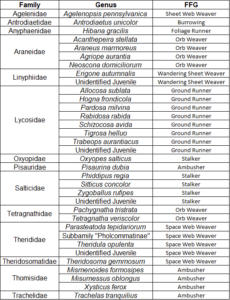
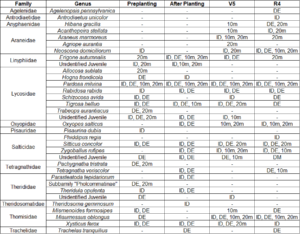
During the 2019 sampling season, 634 spiders were collected across all three drainage ditches, soybean fields and habitat types by both sweep and pitfall sampling. A total of 264 spiders were collected by pitfall trapping, while 370 spiders were collected via foliar sweep sampling. Across both sampling methods, 425 spiders were collected in the drainage ditch associated habitat types (in ditch and ditch edge), while 209 spiders were collected from the soybean field associated habitat types (10m into field and 20m into field). The two-way ANOVAs performed to assess the variation in spider abundance collected by pitfall trapping saw no significant differences due to sampling period or habitat type (Two-Way ANOVA, Sampling Period Effect: {F=0.55, df=3, p=0.65}, Habitat Type Effect: {F=0.31, df=3, p=0.81}, Interaction Effect:{F=1.68, df= 9, p=0.11}). However, the two-way ANOVA performed to assess the variation in spider abundance collected by foliar sweep sampling saw significant differences due to the effects of sampling period, habitat type and their interaction effect (Two-Way ANOVA, Sampling Period Effect: {F=11.82, df=3, p<0.0001}, Habitat Type Effect:{F=8.73, df=3, p<0.0001}, Interaction Effect:{F=3.86, df= 9, p<0.001}).
The amount of overlap in the spider assemblages collected at each habitat type within each sampling period was assessed by a Bray-Curtis dissimilarity analysis, which compared the diversity and relative abundance of the spiders at each habitat to all other habitats. Early in the soybean growing season, ditch associated habitat types (in ditch and ditch edge habitats) were very dissimilar from the soybean field associated habitat types (10m into field and 20m into field habitats). As the soybean growing season progressed, the ditch associated habitat types and the soybean field associated habitat types became less dissimilar, indicating increased overlap between the ditch and field spider assemblages (Table 3).
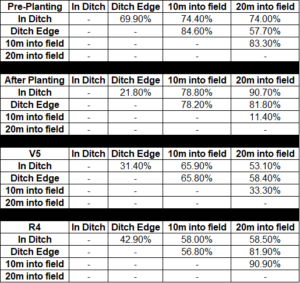
Of the environmental conditions that may influence spider assemblages and spider movement, ground-level temperature and humidity was analyzed to understand its influence within ditches and fields. The highest calculated mean ground temperature inside a drainage ditch was recorded during the “after-planting” sampling period, with a mean ground temperature of 46.30 ± 1.90 degrees Celsius. The highest recorded mean ground temperature inside a neighboring soybean field was also recorded during the “after-planting” sampling period, with a mean ground temperature of 44.50 ± 6.20 degrees Celsius. Both the highest in-ditch and in-field mean relative humidifies were recorded from the “pre-planting”, with a mean relative humidity of 97.70±0.70% in the drainage ditch and 94.00 ± 1.80% in the soybean field. The ground-level temperature and humidity within the drainage ditches and their neighboring croplands were found bear no significant differences (Table 4, Humidity t-test: {t=0.20, df = 1 p=0.43}, Temperature t-test: {t=0.33, df=1, p=0.39).
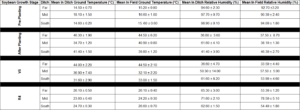
Prey abundance was also analyzed to understand its influence the movement of spiders from drainage ditches to soybean fields. A significant, positive association was found between the prey abundance and spider abundance collected across all habitat types and sampling periods, where as prey abundance increased, so did spider abundance (Figure 1). Prey abundance within ditch associated habitat types and soybean field associated habitat types became more similar as the soybean growing season progressed (Figure 2). This trend in prey abundance combined with our significant findings between prey abundance and spider abundance indicates that spiders in ditches likely move to their adjacent croplands to take advantage of new prey resources with less competitors, as there are less spiders in croplands than within drainage ditches early in the soybean growing season.
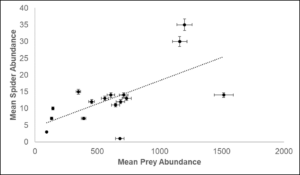

Interestingly, the plant diversity identified in drainage ditches was also found to influence spider assemblages in ditches, albeit in an indirect manner. Sixteen plant families encompassing 20 genera were identified across all three drainage ditches and sampling periods (Table 5). Prey abundance in drainage ditch habitat types were found to be significantly correlated with the plant Shannon diversity within the drainage ditches, where prey abundance in ditches decreased as the plant Shannon diversity in ditches fell as the soybean growing season progressed (Figure 3). As a result of these findings, we conclude that spider abundance in drainage ditches is indirectly affected by the plant assemblages in ditches. The plant assemblages in drainage ditches became more similar in diversity as the soybean growing season progressed, which in turn decreased prey availability for spiders in drainage ditches.
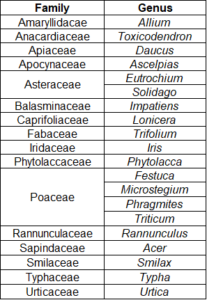
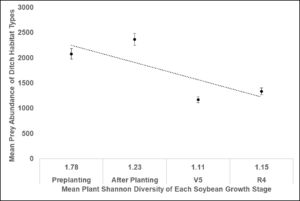
Overall, the spider assemblages present in drainage ditches likely account for a large portion of the spider assemblages present in soybean fields later in the growing season. Of the factors influencing the spider assemblages in drainage ditches, plant diversity indirectly influences spider abundance by dictating the prey abundance for spiders living in drainage ditches. Prey abundance directly influences spider abundances in drainage ditches and their colonization of croplands, as increased prey abundance significantly correlates to increased spider abundance. Two of the most common spider species collected from drainage ditches (Zygoballus rufipes and Siticus concolor) have been shown to colonize neighboring croplands as new survival resources become available, and as a result, are valuable as natural enemies in the croplands they colonize. My findings clearly depict that drainage ditches support prey populations for spiders during times when adjacent soybean fields are prey sparse. The spiders surviving on drainage ditches prey populations then move to soybean fields as the growing season progresses and new prey resources become available, which increases pest predation by spiders in soybean fields. As a result of these findings, I believe that drainage ditches should be considered valuable conservation habitats as sources of beneficial spiders for adjacent croplands.
Education & Outreach Activities and Participation Summary
Participation Summary:
In regards to extension publications, I was featured in an issue of the University of Maryland's Fruit and Vegetable newsletter with an article about spiders as natural enemies in agroecosystems. The citation for this article is the following:
Kutz, D.J. Sources of Spider Diversity in Agroecosystems: Where do the Creepiest Predators in Your Croplands Like to Live? (2019). University of Maryland Vegetable & Fruit News, 10(7), 19–21
In regards to talks and presentations, I presented some preliminary findings of this project at the Entomological Society of America's 2019 Annual Meeting in St. Louis, MO. I also presented an extension talk at the Winter Meeting of the Maryland Organic Food and Farming Association regarding beneficial spiders and drainage ditches as sources of spider diversity and abundance for adjacent croplands. The citation for these talks are the following:
Kutz, D. J., Avanesyan, A., & Lamp, W. (2019, November). Drainage ditches as sources of beneficial spiders on farms to enhance conservation biological control. In Entomology 2019. ESA.
Kutz, D.J. (2020, February). Draiange ditches as sources of beneficial spdiers on farms to enhance conservation biological control. MOFFA Winter Meeting.
Additionally, I am currently in the process of preparing a publication to be submitted to a peer-reviewed academic journal which will focus on data generated from this project.
Project Outcomes
My project will contribute to future sustainability by informing farmers and other agricultural stakeholders of the value of drainage ditches as habitats for beneficial arthropods such as spiders. After presenting to the Maryland Organic Food and Farming Association, many audience members (who were farmers or stakeholders) reported an new understanding of how spiders fit into conservation biological control and the value of nearby uncropped habitats to organic croplands. By offering the agricultural community this insight into how drainage ditches can improve pest control for organic croplands, drainage ditches can be managed by landscape managers in a way that reduces disturbances in ditches to allow spider assemblages to build up and colonize croplands.
Throughout the course of this project, my advisor and I learned a great amount about the impact of spiders as beneficial predators in sustainable agricultural systems. Prior to completing this research project, we understood little of the diversity and abundance of beneficial spiders in uncropped areas, such as drainage ditches, adjacent to organic soybeans, nor how much drainage ditches influence spider assemblages and colonization of croplands. Additionally, this project provided the foundation for another, larger SARE grant to be funded for my advisor through the SARE Novel Approaches Program (project title:“Managing Agricultural Drainage Ditches for Conservation Biological Control on the Delmarva Peninsula"). This purpose of this new grant is to develop ditch management practices to enhance natural enemies that will provide conservation biological control in adjacent crop fields.
As I am finishing my master's degree in the next few weeks, I am seeking a future career in conservation biocontrol, agricultural pest management, or urban pest management.